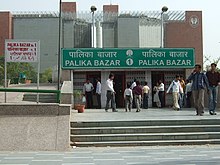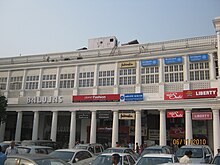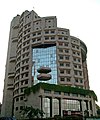Rajiv Chowk, New Delhi, India
Rajiv
Chowk or Connaught Place, New Delhi
From Wikipedia, the free encyclopedia
| This article may require copy editing for clarity, spelling, sentence coherence. (May 2013) |
| Connaught Place Rajiv Chowk | |
|---|---|
| neighbourhood | |
 Skyline at Rajiv Chowk | |
| Nickname(s): cp | |
| Coordinates: 28°37′58″N 77°13′11″ECoordinates: 28°37′58″N 77°13′11″E | |
| Country | India |
| State | Delhi |
| District | New Delhi |
| Government | |
| • Body | New Delhi Municipal Corporation |
| Languages | |
| • Official | Hindi, English |
| Time zone | IST (UTC+5:30) |
| PIN | 110001 |
| Lok Sabhaconstituency | New Delhi |
| Civic agency | New Delhi Municipal Corporation |
Connaught Place (Hindi: कनॉट प्लेस, Punjabi: ਕਨਾਟ ਪਲੇਸ, Urdu: کناٹ پلیس, officially Rajiv Chowk) is one of the largest financial, commercial and business centers in New Delhi, India. It is often abbreviated as CP and houses the headquarters of several Indian firms. It was earlier the headquarters for the British. Its surroundings occupy a place of pride in the city, counted among the top heritage structures in New Delhi. It was developed as a showpiece ofLutyens' Delhi featuring a Central Business District.
Named after H.R.H. Field Marshal The 1st Duke of Connaught and Strathearn, the construction work was started in 1929 and completed in 1933. The Inner Circle of Connaught Place was renamed Rajiv Chowk (after Rajiv Goswami) and the Outer Circle was renamed Indira Chowk by Union Home Minister S.B. Chavan.[1] Today, Connaught Place is one of the most vibrant business districts of Delhi. It is the fourth most expensive office destination in the world, according to global property consultant CBRE Group and the fifth highest priced market in the world according 2013Forbes list. [2]
Contents
[hide]History[edit]
Prior to its construction, the area was a ridge, covered with kikar trees and populated with jackals and wild pigs; residents of Kashmere Gate, Civil Lines area visited during the weekends for partridge hunting.[3] The Hanuman Temple attracted more visitors to the area. These visitors came from the walled city only on Tuesdays and Saturdays and before sunset, as the return trip was considered dangerous.[3]
Villages like Madhoganj, Jaisingh Pura and Raja ka Bazaar were evicted to clear the area for the construction of Connaught Place and the development of its nearby areas. The villages were once situated along the historic Qutb Road, the main road connecting Shahjahanabad, the walled city of Delhi (now known as Old Delhi) to Qutb Minar in south Delhi since the Mughal era. They were relocated in Karol Bagh to the West, a rocky area populated only by trees and wild bushes. However, three structures were spared demolition. These were Hanuman temple, a Jain temple in Jaisinghpura and the Jantar Mantar.[4][5]
Construction[edit]
Plans to have a central business district were developed as the construction of the new capital of Imperial India started taking shape, headed by W.H. Nicholls, the chief architect to the Government of India, who planned a central plaza based on the European Renaissance and Classical style. However Nicholls left India in 1917, and with Lutyens and Baker busy working on larger buildings of the capital, it was Robert Tor Russell, chief architect to the Public Works Department (PWD), Government of India who eventually designed the plaza.[3]
Named after The Prince Arthur, 1st Duke of Connaught (1850–1942), third son of Queen Victoria and uncle of King George VI of England, who visited India in 1921 and laid the foundation of the Council House (now Sansad Bhavan, or Parliament House). It was designed by the architect John Wood the Younger and built between 1767 and 1774.
Connaught Place's Georgian architecture is modeled after the Royal Crescent in Bath. While the Royal Crescent is semi-circular and a three storied residential structure, Connaught Place had only two floors, almost makes a complete circle and was intended to house commercial establishments on the ground with residential space on the first floor.[3] The circle was eventually designed with two concentric circles, creating an Inner Circle, Middle Circle and the Outer Circle with seven roads radiating from a circular central park. As per the original plan, the different blocks of Connaught Place were to be joined from above, employing archways, with radial roads below them, but the circle was 'broken up' to give it a grander scale. Even the blocks were originally planned to 172 meters high, but later reduced to the present two-storied structure with an open colonnade.
Government plans to have the New Delhi Railway Station built inside the Central Park were rejected by the Railways as they found the idea impractical, and instead it chose the nearby Paharganj area. Finally the construction work began in 1929, as principal construction of the Viceroy House (present Rashtrapati Bhavan), Central Secretariat, Parliament House, and All-India War Memorial, India Gate was winding down and was complete by 1933, long after the inauguration of the city in 1931.[3][6]
Early years[edit]
Early commercial establishments were of traders from Kashmere Gate area, Kaventer's, Galgotia and Snowhite. Most of the Indian princely states had their local homes in the nearby areas around King's way (present Rajpath), and would frequent shops for designer clothes, artifacts, shoes, and pianos. Regal cinema, the first cinema of CP also opened in time, it went on to host popular concerts, theatre groups and ballet performances. Odeon and Rivoli followed Regal, and the Indian Talkie House opened in 1938.[3][6][7] Initially only Indian snacks were available at CP, but gradually restaurants started opening in the plaza, with names like Kwality, United Coffee House and others offering Continental and Mughlai cuisines.[8] Wenger's, the confectioners, was one of the first shops in CP, it also owned the largest restaurant in New Delhi on the first floor of their present A-Block outlet. Originally established in 1926 as Spencers in Kashmere Gate, Wenger's was owned by a Swiss couple and introduced Delhi to pastries and homemade Swiss chocolates, though in its early years it too was patronized mostly by Britisher officers, Indian royalty and some foreign-returned businessmen, for Delhi was still a city of classical tastes of the walled city. Davico's across the Connaught Plaza, and Standard restaurant were popular names for decades before fading away. Another old timer, the Embassy Restaurant, was opened in 1948.[7]
The Imperial, New Delhi’s first luxury hotel opened in 1931 on Queen's Way, (present Janpath), which eventually became a haunt for the royalty and at place for political talks. It was here that Jawaharlal Nehru, Mohandas K. Gandhi, Muhammad Ali Jinnah and Lord Mountbatten met to discuss the Partition of India and the birth of Pakistan.[9][10]
Residents moved in gradually into first floor quarters which were almost full by 1938, but it was another decade before the plaza became the busy marketplace that it became later, as World War II started and the Independence movement reached a feverish pitch. Markets experienced dwindling sales, but post-independence business started increasing by the 1950s.[3][6][7]
Post-independence[edit]
Until the 1980s, a Phatphat Sewa, a Harley Davidson rickshaw service, took visitors from CP to Red Fort and Chandani Chowk, before it was stopped due to pollution concerns.[11] The empty block of the Inner circle was filled up in late 1970s with the construction of an underground market, a first in Delhi, Palika Bazaar at the junction point. Stretching up to the Outer circle, it also came with an adjoining underground parking lot. Also in 1970s came State Emporiums on Baba Karak Singh Marg radial.[5] However, a major alteration in the skyline was the addition of red sandstone (inspired by the historic Red Fort) and glass skyscraper, the Jeevan Bharti building (LIC building), designed by architect Charles Correa. In 1986, it towered over the low-lying and predominantly white Connaught Place and was criticised for being too futurist, but gradually as other skyscrapers were built on the periphery, the debate faded away.[12]
Cinemas[edit]
After the talkies made way into Indian cinema in 1931, and became a craze in the 1930s and the 40s, four theatres came up within Connaught Place Plaza: Regal, Rivoli, Odeon and a short-lived "Indian Talkie House" that opened in 1938, all making CP the entertainment hub of New Delhi. Regal, the first theatre of CP, opened in 1932 by Sir Sobha Singh. It was designed by architect Walter Sykes George and mainly hosted stage performances. In the coming years it hosted Western Classical music artists, Russian ballet and British theatre groups, and soon morning and afternoon movie shows were started. The next theatre to be built in CP, was the Plaza in 1940, designed by Sir Rober Tor Russell, the architect of Connaught Place himself. It was owned by director and actor Sohrab Modi until in the early 1950s. Odeon was built in 1945, city’s second 70mm screen, after "Shiela Cinema" in Paharganj. Rivoli, close to Regal was the smallest theatre of the area. Half a century later most of the theatres were still running, though ownership had changed hands for most. Plaza and Rivoli are owned by multiplex giant PVR Cinemas, while Odeon is a joint venture with Reliance Big Pictures.[3][13]
Today[edit]
The area is instantly recognisable on any map of Delhi, being the big circle in the middle with radial roads spreading out in all directions, like spokes on a wheel. Eight separate roads lead out from CP's inner circle, named Parliament Street and Radial Roads 1 through 7. Twelve different roads lead out from Connaught Circus, the outer ring; the most well-known of these isJanpath, the continuation of Radial Road 1. It is a logically planned area and houses one of India's first under ground market-Palika Bazaar (Municipal Market), named after nagarpalika. The Outer Circle is known as the Connaught Circus (officially Indira Chowk),having rows of restaurants, shops and hotels. The Middle Circle has offices and small eating outlets.[14]
The central park of Connaught Place has long been a venue for cultural events. In 2005–06, it was rebuilt after the construction of the Delhi Metro station below it. That station, Rajiv Chowk, is the interchange for the Yellow and Blue lines of the Metro and one of the largest and busiest stations in the network. Connaught Place today plays host to various cultural programs in the central park area . The first Starbucks Coffee store in Delhi was opened in Connaught Place in Hamilton House, A block. In January 2013 CP also hosted the 'dilli ke pakhwaan' on Baba Kharak Singh Marg which proved to be a great success.
Delhi blasts[edit]
Main article: 13 September 2008 Delhi bombings
Connaught Place was the site of two of the five terrorist blasts that made up 13 September 2008 Delhi bombings.[15] Ten people were injured, police and witnesses said that the bombs went off in garbage cans in and around Connaught Place. There was also one bomb blast in the Central Park near Connaught Place. Authorities also discovered two undetonated bombs in Delhi, one located at the Regal cinema complex in Connaught Place.[16] As a response, all garbage cans have been removed from the area for security reasons.
Redevelopment plans[edit]
By the late 2000s Connaught Place had lost much of its old glory, even though the charm of the market never failed to attract foot traffic. As a part of its 'Return to Heritage Project', the New Delhi Municipal Council (NDMC) prepared a plan to revamp and redevelop this proud landmark of Delhi. The plan includes provision of heritage sensitive signages, engineering improvements of roads, drainage sewerage, water supply and substations etc., development of a traffic management plan, provisions of street furniture including adequate parking, walkways etc. and enhancing the structural stability of all buildings including retrofitting for earthquake resistance. All these components have been identified based on studies conducted by various reputed agencies like SPA, RITES, CMCCC, NTPAC, etc.
The redevelopment work was slated to be completed in time for the 2010 Commonwealth Games held at Delhi. But due to huge cost overruns and undue delays,[17] this deadline was not met. The Performance Audit Report prepared by Controller and Auditor General, India, on the Commonwealth Games 2010 concluded that there were "significant deficiencies in contract management, with consequent avoidable expenditure". Moreover, the mis-management and delays caused great inconvenience to the shoppers and shop-owners alike, and led to a decline in trade.[18] Many store-owners complained of erratic power supply and lost air-conditioning in their shops during the renovation work.
Work on the renovation was resumed soon after the Commonwealth Games, and is currently underway in full swing to meet the new deadline of December 2012.
The globally unique international art project United Buddy Bears was presented in New Delhi on the Connaught Place during the summer 2012.
Films[edit]
Over the years, Connaught Place has been location many films including sequences in Hazaaron Khwaishein Aisi (2003), Pyaar Ke Side Effects (2006), 3 Idiots(2009), Aisha (2010), Delhi Belly (2011), Rockstar (2011), Ahista Ahista (2006), Agent Vinod (2012 film), Vicky Donor (2012) and Hate Story (2011), Special 26(2013)
See also[edit]
Other commercial centres in Delhi metropolitan area:
- Janakpuri District Centre
- Netaji Subhash Place
- Nehru Place
- Bhikaji Cama Place
- Rajendra Place
- Shivaji Place
- Faridabad
- Ghaziabad
- Karol Bagh
- Laxmi Nagar
- Gurgaon
- NOIDA
Visitor attractions[edit]
- Agrasen ki Baoli, Connaught Place
- The Imperial, New Delhi
- National Philatelic Museum, New Delhi


















































No comments:
Post a Comment